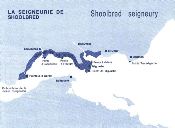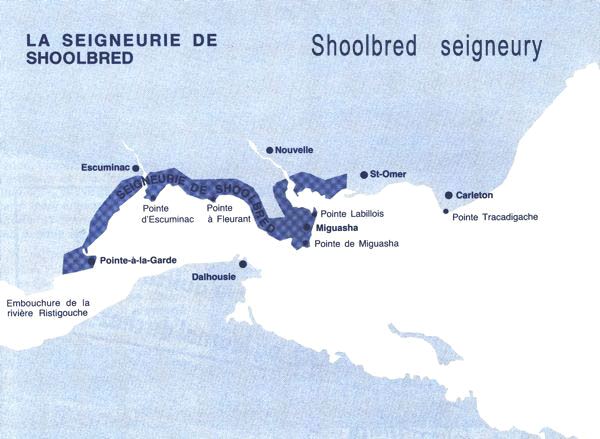The Seigniory of Shoolbred
Before the arrival of Europeans in North America, the Baie des Chaleurs was part of a vast territory that served as fishing and hunting grounds for the Micmac (Mi’kmaq), an aboriginal nation in the Algonquin family. During the French Regime between 1534 and 1760, the only visitors of European descent that appear to have visited the outer reaches of the Baie des Chaleurs region were a few seasonal fisherman, and missionaries charged with converting native people.
After the English victory, British soldiers who helped to seize the colony from the French decided to settle in this land of promise. Miguasha was one such settlement site where the Wafer, Connors and Hayes families put down roots. Descendants of the original soldiers still live there today.
Back in those days, loyal service to the King was repaid with grants of land and seigniories. A seignior owned the lands, and even if he did not reside in the area, he received an annual rent from the citizens who did.

 (76 kb)It was probably for services rendered that an English merchant by the name of John Shoolbred was offered, in 1788, land in the Gaspé Peninsula that eventually carried the name of the Seigniory of Shoolbred. The seigniory comprised a large strip of land about one to two kilometres long that ran along the Ristigouche River. It began at Pointe-à-la-Garde and ended at the present-day boundary between the municipalities of Nouvelle and Saint-Omer. The little peninsula of Miguasha was part of this Shoolbred territory.
(76 kb)It was probably for services rendered that an English merchant by the name of John Shoolbred was offered, in 1788, land in the Gaspé Peninsula that eventually carried the name of the Seigniory of Shoolbred. The seigniory comprised a large strip of land about one to two kilometres long that ran along the Ristigouche River. It began at Pointe-à-la-Garde and ended at the present-day boundary between the municipalities of Nouvelle and Saint-Omer. The little peninsula of Miguasha was part of this Shoolbred territory.
John Shoolbred never lived on his seigniory. In 1801, it was left to his son James, a merchant from Charleston, North Carolina. He resold it in 1809 to Matthew Stewart, a merchant from Saint-Omer.
After the abolition of the seigniorial system in 1855, some Acadians settled in the local countryside, among them the Caissy, Roy, Landry and Bienvenue families. The region became the Municipality of Shoolbred, but was partitioned in 1907. Five years later, each half was renamed: the western half became the Municipality of Escuminac, and the eastern half the Municipality of St-Jean-l’Évangéliste.
St-Jean-l’Évangéliste changed its name in 1953 to become the Municipality of Nouvelle, to which Miguasha Point was annexed in 1961.
After the English victory, British soldiers who helped to seize the colony from the French decided to settle in this land of promise. Miguasha was one such settlement site where the Wafer, Connors and Hayes families put down roots. Descendants of the original soldiers still live there today.
Back in those days, loyal service to the King was repaid with grants of land and seigniories. A seignior owned the lands, and even if he did not reside in the area, he received an annual rent from the citizens who did.

 (76 kb)It was probably for services rendered that an English merchant by the name of John Shoolbred was offered, in 1788, land in the Gaspé Peninsula that eventually carried the name of the Seigniory of Shoolbred. The seigniory comprised a large strip of land about one to two kilometres long that ran along the Ristigouche River. It began at Pointe-à-la-Garde and ended at the present-day boundary between the municipalities of Nouvelle and Saint-Omer. The little peninsula of Miguasha was part of this Shoolbred territory.
(76 kb)It was probably for services rendered that an English merchant by the name of John Shoolbred was offered, in 1788, land in the Gaspé Peninsula that eventually carried the name of the Seigniory of Shoolbred. The seigniory comprised a large strip of land about one to two kilometres long that ran along the Ristigouche River. It began at Pointe-à-la-Garde and ended at the present-day boundary between the municipalities of Nouvelle and Saint-Omer. The little peninsula of Miguasha was part of this Shoolbred territory.John Shoolbred never lived on his seigniory. In 1801, it was left to his son James, a merchant from Charleston, North Carolina. He resold it in 1809 to Matthew Stewart, a merchant from Saint-Omer.
After the abolition of the seigniorial system in 1855, some Acadians settled in the local countryside, among them the Caissy, Roy, Landry and Bienvenue families. The region became the Municipality of Shoolbred, but was partitioned in 1907. Five years later, each half was renamed: the western half became the Municipality of Escuminac, and the eastern half the Municipality of St-Jean-l’Évangéliste.
St-Jean-l’Évangéliste changed its name in 1953 to become the Municipality of Nouvelle, to which Miguasha Point was annexed in 1961.
Site map | Feedback | Links | Sources | Credits
The Seigniory of Shoolbred
<< Of cliffs and men | A World Heritage Site >>

Title: The Seigniory of Shoolbred
Author: Gaspésie, vol. 23, no. 4
Sources: Parc national de Miguasha
Year: 1985
Description:
The Seigniory of Shoolbred was one of eight seigniories conceded under the British regime in Lower Canada, District of Quebec. Conceded on July 24, 1788, it extended from Pointe-à-la-Garde to St-Omer and included Miguasha Point. Image taken from the magazine “Gaspésie”, December 1985 issue, volume XXIII, number 4.


